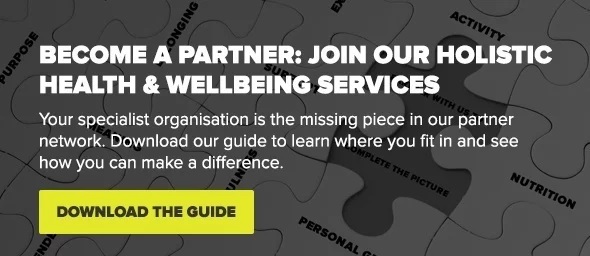
Bridge believes that a holistic approach to wellbeing is required for tackling the UK’s wildfire of chronic illnesses. As Dr Brock Chisholm, the first Director-General of the World Health Organisation (1948–1953) famously said, “without mental health there can be no true physical health.” While mental and physical health are important elements of wellbeing, research by the UK government’s Foresight Project on Mental Capital and Wellbeing has broadened the spectrum to include a list of Five Ways to Wellbeing; connecting, getting active, taking notice or mindfulness, continuous learning, and giving to others.
The scope of activities that are required to provide such an encompassing support service means that it’s difficult for any single organisation to succeed. This is why we’ve embraced partnership working. Through partnership working, we’ve been able to combine our limited resources to reach a greater number of people with better services, which is why we’re inviting you to consider joining the Bridge Partner Network. Because not everyone will agree on what a good partnership looks like, it’s important to find a good fit for your organisation. This blog will introduce you to our view on partnership working, so you can decide for yourself if a match has been made.
What is Partnership Working in Health and Social Care?
Partnership working in health and social care brings together separate organisations so that they can benefit from pooled expertise, resources and power sharing. The goal of a partnership is to enhance the efficiency and quality of service provision.
According to the Knowledge Biz, most partnerships share the following traits:
- All parties involved have some sort of personal stake in the partnership.
- All partners are working towards a common goal.
- The partners have a similar ethos or system of beliefs.
- The partners work together over a reasonable period of time.
- There is a mutual understanding of the value of each partner’s contribution.
- There is respect and trust between the partners.
A Definition of Partnership Working in Health and Social Care
Searching for a definition of ‘partnership working’ delivers a wide range of answers. Even within the singular field of social work, there are contradictory takes on what a partnership means in practical terms. Some hold that a working relationship becomes a true partnership when all parties contribute a reasonable measure of service resources. Others believe that consultation can count as an equivalent to service delivery.
According to Jo Tunnard, former associate director of Child Poverty Action Group and current social welfare consultant:
The essence of partnership is sharing. It is marked by respect for one another, role divisions, rights to information, accountability, competence, and value accorded to individual input. In short, each partner is seen as having something to contribute, power is shared, decisions are made jointly and roles are not only respected but are also backed by legal and moral rights.
Blackburn Anglican, a Lancashire church with a vision of transforming communities through partnership working, defines the concept as follows:
Partnerships can be formed between a number of individuals, agencies or organisations with a shared interest. There is usually an overarching purpose for partners to work together and a range of specific objectives. Partnerships are often formed to address specific issues and may be short or long term.
We agree with Blackburn Anglican’s focus on the need for communication, coordination and cooperation. At Bridge, we find that successful partnerships depend more on these elements than it does on a particular role division.
Different Models of Partnership Working
For Bridge, the purpose of partnership working is to deliver a better service to a great number of people. With this goal in mind, we embrace the parts of the many different models of partnership working. The four primary models of partnership working that we borrow from are Networking, Referral Systems, Consortium, and Multi-Agency Working models.
- The Networking Model is the simplest model of partnership where organisations meet up regularly to share their practice and discuss areas of commonality. “There is no commitment to go further unless two or more organisations decide to do so. The purpose is for organisations to be able to take up opportunities that may arise, such as funding or delivering specific services to clients, without having to repeat niceties of getting to know each other.”
- The Referral Systems model is a partnership that’s set up for the specific purpose of enabling inter-organisational referrals. “Organisations agree on processes to share information and refer clients to the other agency. There may be a written agreement although it would be more usual to just agree on a procedure and forms to use. The purpose is for the referral of clients to be as smooth as possible and save extra time in repeating the gathering of information.”
- The Consortium Model is a partnership set up for a mutually beneficial purpose, such as jointly bidding for resources or joining forces to act as a pressure group. “There may be a written agreement, such as a financial contract if a funding bid is successful or terms of reference for a pressure group. Organisations may undertake their work totally separately or may choose to work alongside others. The purpose is to act together, believing that the whole is greater than the sum of its parts and will garner more success.”
- The Multi-Agency Working Model is one where two or more organisations share resources to deliver work jointly. Partnerships based on this model need to be clearly planned, and relationships have to be carefully managed to ensure success. “A level of trust needs to be built between individuals in the partner organisations for this to work. Organisations would normally draw up a partnership agreement of some description to clarify the relationship. The purpose is to work together believing that this will achieve more effective results than working separately.”
“Which Partnership Network is Right for Us?”
As a potential partner, you’re going to wonder which network is best for you. The answer will depend on factors such as the nature of your services, your goals, and your organisational culture. If you’re considering the Bridge Partner Network, you can judge your fit by looking at our core principles:
- The aim of the partnership needs to be agreed and understood by all the partners.
- The partnership needs to be steered by clear, effective leadership.
- Clarity on role division. Each partner’s role has to be identified and clearly communicated to others in the partnership.
- Mutually-beneficial ownership. Each of the partners must experience that they share in the ownership of the partnership and that they benefit from the relationship.
- Administrative resources. Time and resources have to be allocated for the administration and operation of the partnership.
- Unity in variety. While partners will share certain goals and motivations, differences in organisational cultures must be embraced and celebrated.
- Open communication. Suggestions, ideas and conflicts must be addressed upfront to ensure that collaboration remains a source of inspiration and not of tension.
Benefits of Integrated Health and Social Care Teams
In their document, Health and Social Care Working together to Develop the Workforce, NHS Wales reports back on the benefits they’ve attained through partnership working. Numerous benefits were noted in relation to intermediate care/reablement (p60), services to children and young people (p61), adult mental health (p62), and provision of holistic health and wellbeing services (p63). Benefits of integrated health and social care teams listed include:
- Establishment of a one-stop shop for patients.
- Delivery of care closer to clients’ homes.
- Prompt provision of access to the most appropriate team member and a more comprehensive range of services.
- Increased choice and autonomy for service users and respite/support for carers.
- The ability to support people to remain in their own homes.
- An improvement in information sharing with patients.
- Reduction in duplication of assessments and services.
- A better understanding of team roles and contribution to care.
- Improved job satisfaction for support volunteers and professionals.
- The development of a multi-skilled workforce.
- A reduction of support worker overlap and better utilisation of the skills of front-line professionals.
- A shared evaluation framework and performance indicators for health and social care.
- A reduction in emergency admissions and length of stay.
- A reduction in multiple admissions for patients with chronic conditions.
- Facilitation of early and safe discharge from hospital.
- Measurable risk averted or impact reduced.
- The development of a generic health and social care role.
- An improved retention of support workers.
- More effective use of joint resources.
- The ability to monitor difficult to reach patients.
- Shared learning across organisations.
The NHS Health and Care Act on Partnership Working
According to The Health and Social Care Act of 2012 (Sections 13N and 14Z1), the NHS has a duty to promote and secure integrated care where it will improve the quality of services, and reduce inequalities in accessing services or improve outcomes.
The following presentation by the College of Social Work (presently known as the British Association of Social Workers, or BASW) discusses how the act impacts integration, cooperation and partnerships in the UK, including:
- What the Act says and the duties that fall to local authorities.
- The duty to promote greater integration.
- The duty to cooperate.
- Integration, cooperation and partnerships in practice.
- Examples of working together.
Bridge’s Holistic Partnership Network
Bridge is always looking to form new partnerships with wellbeing services providers that share our goals and core values. If you’d like to learn more about us before deciding if the Bridge Partner Network would be a good fit for your organisation, download The UK Specialist’s Guide to Providing Holistic Health and Wellbeing Services.


